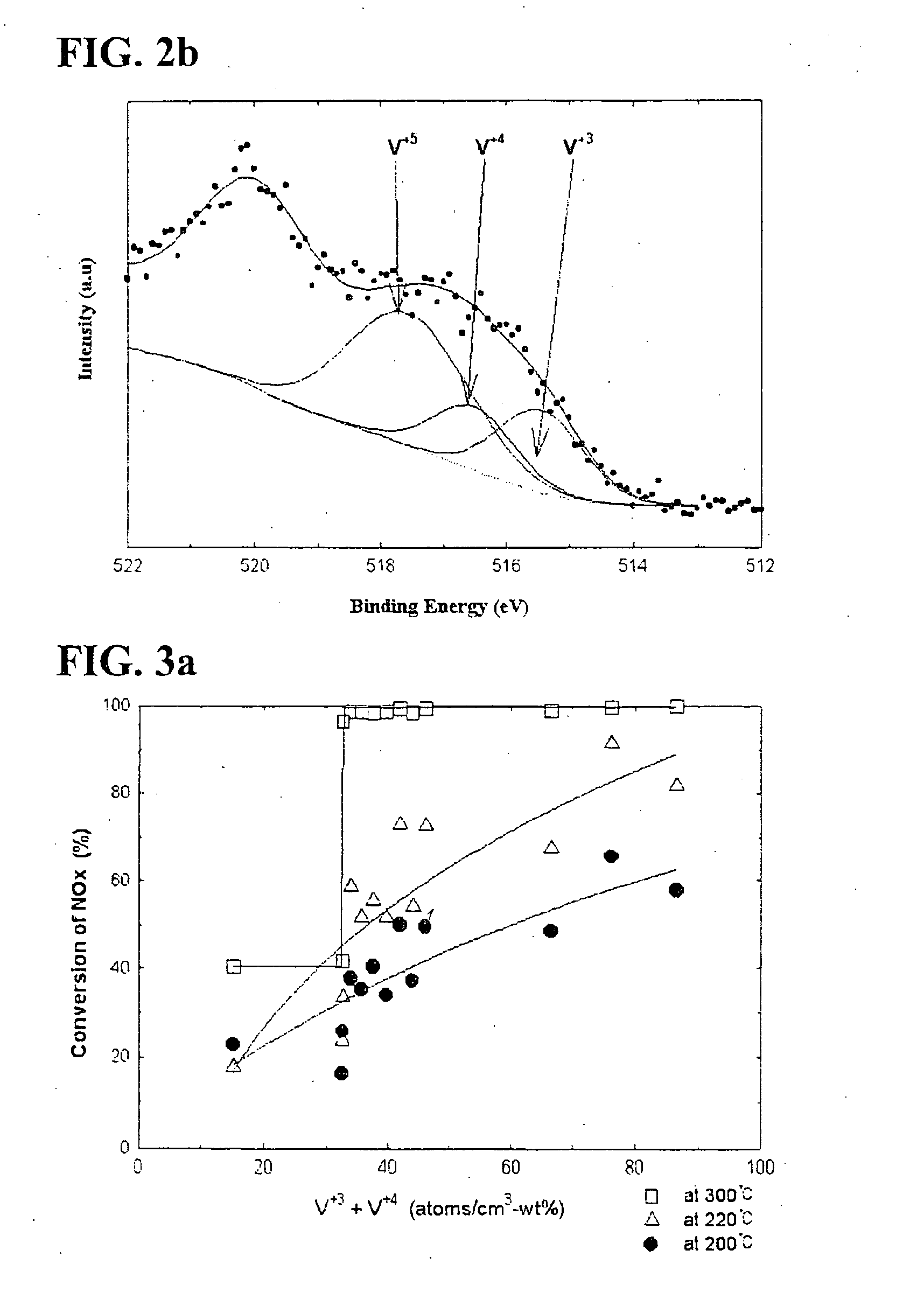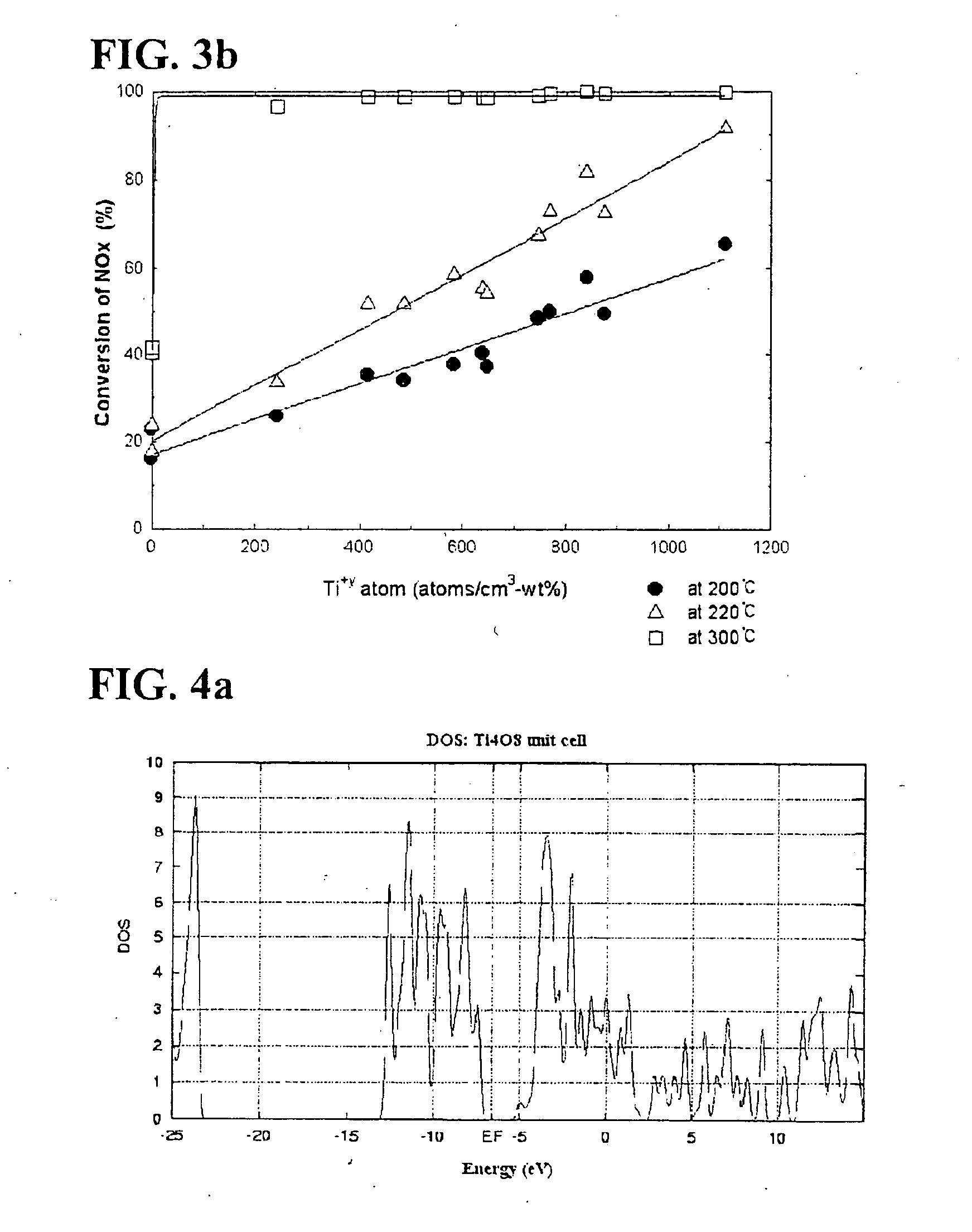Vanadium/titania-based catalyst for removing introgen oxide at low temperature window, and process of removing nitrogen oxide using the same
a technology of introgen oxide and catalyst, which is applied in the direction of physical/chemical process catalyst, chemical process, other chemical processes, etc., can solve the problems of not securing economic efficiency, affecting the efficiency of nitrogen oxide removal, etc., to achieve high activity and high activity
- Summary
- Abstract
- Description
- Claims
- Application Information
AI Technical Summary
Benefits of technology
Problems solved by technology
Method used
Image
Examples
preparation examples 1 to 10
, AND COMPARATIVE PREPARATION EXAMPLES 1 TO 5
[0094] 1) Measurement of a Molar Ratio (O / Ti) of Oxygen Combined with Titanium to Titanium
[0095] Samples according to Preparation Examples 1-10 and Comparative Preparation Examples 1-5 were prepared using titania as a support as shown in the following Table 1. Titania was analyzed using an XPS (ESCALAB 201 manufactured by VG Scientific Co.) to measure a molar ratio (O / Ti) of oxygen combined with titanium to titanium.
[0096] Ti 2p of titania according to Preparation Example 1 described in the following Table 1 is illustrated in FIG. 5. As shown in FIG. 5, in case of titania onto which vanadium is not impregnated, only titanium with a valence of 4+ exists. This observation was found in other titanias according to Preparation Examples 2-10 and Comparative Preparation Examples 1-5.
[0097] Additionally, O 1 s of titania according to Preparation Example 1 was analyzed in conjunction with Ti 2p of titania. Oxygen in titania existed in a form of...
examples 1 to 10
, AND COMPARATIVE EXAMPLES 1 TO 5
[0105] 0.91 g ammonium metavanadate (NH4VO3: 20555-9 manufactured by Aldrich Chemical Co.) was dissolved in 30 mL distilled water. 1.4 g oxalic acid was added to water containing ammonium metavanadate to increase the solubility of ammonium metavanadate in water and control a valence of vanadium. Each of titania supports according to Preparation Examples 1-10, and Comparative Preparation Examples 1-5 was added to the resulting solution in an amount of 20 g to give a slurry. The slurry was heated at 70° C. using a vacuum evaporator while it is agitated, and then dried at 100° C. for 24 hours. Thereafter, a calcination was performed at 400° C. for 6 hours under an air atmosphere to produce a catalyst. The catalyst was analyzed using an elementary analysis device (Optima 3000XL manufactured by Perkin Elmer Co.), and it is confirmed that the catalyst includes 2.0 wt % vanadium based on a weight of titania. Further, a specific surface area (m2 / g) of the ca...
experimental example 1
Analysis of Conversion of Nitrogen Oxides According to a Temperature for each Catalyst
[0107] Conversions of nitrogen oxides according to a temperature for the catalysts described in the Table 2 were calculated and illustrated in FIG. 1. In this regard, a temperature of a reactor varies within a range of 150-400° C., a concentration of nitrogen oxides was 800 ppm, and a molar ratio of NH3 / NOx was controlled to 1.0. Furthermore, concentrations of oxygen and moisture were respectively 3 and 6 volume %, and a space velocity was 60,000 hr−1. The catalysts were maintained at 400° C. for 1 hour under the atmosphere to prevent moisture adsorbed in the catalysts before nitrogen oxides were converted and valences of vanadium and titanium from affecting the SCR, and then cooled to a reaction temperature.
[0108] With reference to FIG. 1, in the case of most of the catalysts except for catalysts of Comparative Examples 4 and 5, conversions of nitrogen oxides were high at a relatively high tempe...
PUM
| Property | Measurement | Unit |
|---|---|---|
| temperature | aaaaa | aaaaa |
| temperature | aaaaa | aaaaa |
| temperature | aaaaa | aaaaa |
Abstract
Description
Claims
Application Information
 Login to View More
Login to View More - R&D
- Intellectual Property
- Life Sciences
- Materials
- Tech Scout
- Unparalleled Data Quality
- Higher Quality Content
- 60% Fewer Hallucinations
Browse by: Latest US Patents, China's latest patents, Technical Efficacy Thesaurus, Application Domain, Technology Topic, Popular Technical Reports.
© 2025 PatSnap. All rights reserved.Legal|Privacy policy|Modern Slavery Act Transparency Statement|Sitemap|About US| Contact US: help@patsnap.com



